 The “Hands-On” Method
The “Hands-On” Method
Unlike many horse trainers out there, I did not grow up with horses in my back yard. In fact, I began my journey with horses comparatively late in life. I had ridden on and off from early in my youth, but it wasn't until several years after I moved to Oregon in 1991 that I had the opportunity to make a serious study of the nature and the training of horses.
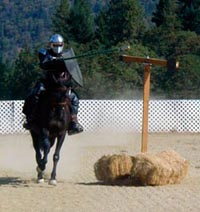 A few years later, I began training a horse for Medieval Mounted Combat and Gaming. Equestrian activities which, more than many, put a horse's training, physical ability and steadiness to a serious test.
A few years later, I began training a horse for Medieval Mounted Combat and Gaming. Equestrian activities which, more than many, put a horse's training, physical ability and steadiness to a serious test.
Since then, I have tried my hand at an array of different riding and training styles and found those euphemistically called “Natural Horsemanship” and those used in "Classical Riding" to be not only the most intuitive and effective for me personally, but also very similar at their core. I have therefore adapted methods I have observed, and those I discovered in written works dating back several hundred years, to fit my own understanding of the equine nature. Through this I seek to create a syntheses of modern and classical methods that, it turns out, are not all that dissimilar; despite the disdain many practitioners of the two often have for the other.
Just a few of the skills we train for.
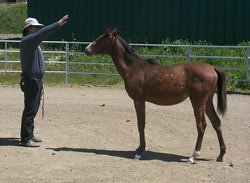 Like most other horse trainers, I have put my own brand on the methods I use and teach. I call my method “Hands-On Horse Training”. I chose this name because so much of the training takes place not in the saddle, but from the ground, literally using hands-on direction and manipulation to balance and straighten the physical asymmetry natural to horses and at the same time, create a foundation of respect and trust between horse and trainer. This method employs repetitive, consistent direction to gently acclimate the horse to instinctively respond to cues, first from the ground, then later from the saddle.
Like most other horse trainers, I have put my own brand on the methods I use and teach. I call my method “Hands-On Horse Training”. I chose this name because so much of the training takes place not in the saddle, but from the ground, literally using hands-on direction and manipulation to balance and straighten the physical asymmetry natural to horses and at the same time, create a foundation of respect and trust between horse and trainer. This method employs repetitive, consistent direction to gently acclimate the horse to instinctively respond to cues, first from the ground, then later from the saddle.
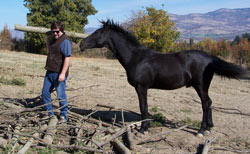 With these techniques I condition the horse to respect and trust its rider, achieving exceptional ground manners, while simultaneously desensitizing it to extraneous input from the world around us and straightening and balancing the horse. This makes for a horse that is far less likely to startle or spook when confronted with new experiences and a rider with more confidence in their mount. You might be surprised what types of stimuli a horse can be conditioned to accept as unimportant.
With these techniques I condition the horse to respect and trust its rider, achieving exceptional ground manners, while simultaneously desensitizing it to extraneous input from the world around us and straightening and balancing the horse. This makes for a horse that is far less likely to startle or spook when confronted with new experiences and a rider with more confidence in their mount. You might be surprised what types of stimuli a horse can be conditioned to accept as unimportant.
Through straightness and balance training the horse develops the ability to carry a rider more naturally and perform better physically. A great many common behavior problems really stem from the horse's reaction to being out of balance and physically unable to do what is asked and often disappear once the horse's balance issues are corrected.
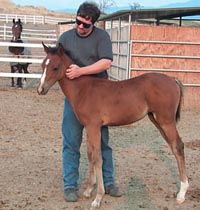 The gentle nature of the “Hands-On” method allows training to begin at a very young age. This makes it ideal for horses that are not yet ready for saddle work. Through these techniques a solid foundation can be laid, allowing for the behavioral responses desired in a horse to be in place once it is ready to begin under saddle. By starting at a young age, it is also easier to guide the horse's physical development, to achieve better balance and collection, than it is to try to change the horse after it has fully matured.
The gentle nature of the “Hands-On” method allows training to begin at a very young age. This makes it ideal for horses that are not yet ready for saddle work. Through these techniques a solid foundation can be laid, allowing for the behavioral responses desired in a horse to be in place once it is ready to begin under saddle. By starting at a young age, it is also easier to guide the horse's physical development, to achieve better balance and collection, than it is to try to change the horse after it has fully matured.
The goal is that by the time you put the saddle on your horse for the first time, it should be conditioned to instinctively accept a rider, be able to move from light pressure and stop quietly. It should also carry weight more evenly on all four feet than it would if left balanced as horses have evolved to carry themselves without a rider. All of this occurs while remaining calm and mentally engaged.
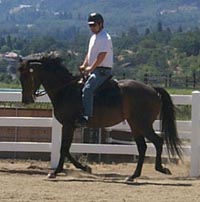 Once you have this training and conditioning in place, you are ready to help your horse learn to move properly while carrying a rider. After that, you should be able to move forward toward whatever riding discipline you prefer. This is because your horse should be flexing and collecting willingly, facilitating agile and balanced movement, which is a part of all riding.
Once you have this training and conditioning in place, you are ready to help your horse learn to move properly while carrying a rider. After that, you should be able to move forward toward whatever riding discipline you prefer. This is because your horse should be flexing and collecting willingly, facilitating agile and balanced movement, which is a part of all riding.
In conclusion, let me say that the “Hands-On” method was never intended to replace all other forms of training. If I have learned anything, I have learned there is no “One Right Way” to train a horse, though I do believe there many wrong ones. What I offer is a relaxed and gentle way to work toward the partnership between horse and rider. This I believe should be the goal of all good equestrian training.
